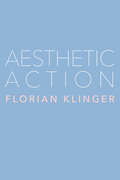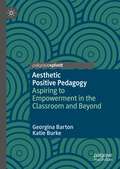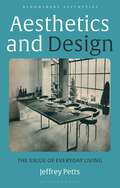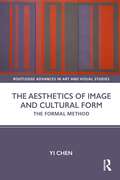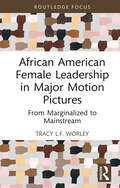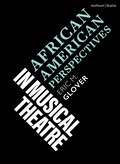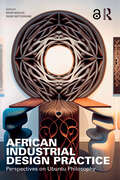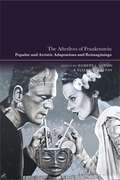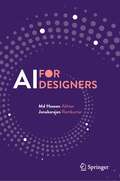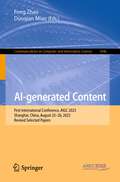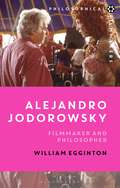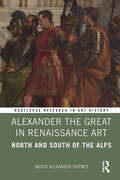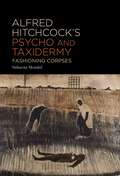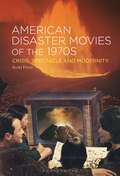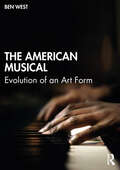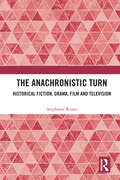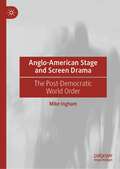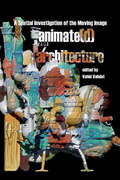- Table View
- List View
Aesthetic Action
by Florian KlingerIn this new book, Florian Klinger gives readers a basic action-theoretical account of the aesthetic. While normal action fulfills a determinate concept, Klinger argues, aesthetic action performs an indeterminacy by suspending the action's conceptual resolution. Taking as examples work by Tino Sehgal, Kara Walker, Mazen Kerbaj, Marina Abramović, Cy Twombly, and Franz Kafka, the book examines indeterminacy in such instances as a walk that is at once leisurely and purposeful, a sound piece that is at once joyous and mournful and mechanical, or a sculpture that at once draws one in and shuts one out. Because it has irresolution as its point, aesthetic action presents itself as an unsettling of ourselves, our ways, our very sense of who we are. As performers of such action, we don't recognize one another as bearers of a shared human form as we normally would, but find ourselves tasked anew with figuring out what sharing a form would mean. In conversation with philosophers such as Kant, Hegel, Wittgenstein, and Anscombe; political thinkers such as Marx and Lorde; and contemporary interlocutors such as Michael Thompson, Sebastian Rödl, and Thomas Khurana, Klinger's book makes a case for a conception of the human form that systematically includes the aesthetic: an actualization of the form that is indeterminate and nevertheless rational. The book gives the project of Western philosophical aesthetics a long-overdue formulation for our present that aims to do justice to contemporary aesthetic production as it actually exists. It will appeal to those working in philosophy, art, and political thought.
Aesthetic Action
by Florian KlingerIn this new book, Florian Klinger gives readers a basic action-theoretical account of the aesthetic. While normal action fulfills a determinate concept, Klinger argues, aesthetic action performs an indeterminacy by suspending the action's conceptual resolution. Taking as examples work by Tino Sehgal, Kara Walker, Mazen Kerbaj, Marina Abramović, Cy Twombly, and Franz Kafka, the book examines indeterminacy in such instances as a walk that is at once leisurely and purposeful, a sound piece that is at once joyous and mournful and mechanical, or a sculpture that at once draws one in and shuts one out. Because it has irresolution as its point, aesthetic action presents itself as an unsettling of ourselves, our ways, our very sense of who we are. As performers of such action, we don't recognize one another as bearers of a shared human form as we normally would, but find ourselves tasked anew with figuring out what sharing a form would mean. In conversation with philosophers such as Kant, Hegel, Wittgenstein, and Anscombe; political thinkers such as Marx and Lorde; and contemporary interlocutors such as Michael Thompson, Sebastian Rödl, and Thomas Khurana, Klinger's book makes a case for a conception of the human form that systematically includes the aesthetic: an actualization of the form that is indeterminate and nevertheless rational. The book gives the project of Western philosophical aesthetics a long-overdue formulation for our present that aims to do justice to contemporary aesthetic production as it actually exists. It will appeal to those working in philosophy, art, and political thought.
Aesthetic Positive Pedagogy: Aspiring to Empowerment in the Classroom and Beyond
by Georgina Barton Katie BurkeThis book introduces and explores a new pedagogical approach, Aesthetic Positive Pedagogy (APP), for teachers and students in a variety of educational contexts. The book is built on the need for educational institutions and communities to seriously consider a strong positive approach to learning and teaching, ultimately leading to a better world. Based on pre-existing philosophies such as positive pedagogy and critical pedagogy, APP encourages teachers to carefully consider their language use as well as other modal resources in the classroom. Using aesthetic experience as a core to learning, teachers can embed an approach to learning and teaching that supports wellbeing and resilience as well as caring and compassionate citizenship in their students. The authors outline what an APP approach to learning and teaching looks, feels and sounds like in different educational contexts such as in schools and higher education, and explore how it might be implemented in face-to-face as well as online learning. The book’s findings will apply to postgraduate students and academics in education and the creative arts, as well as teachers and leaders in schools.
Aesthetics and Design: The Value of Everyday Living (Bloomsbury Aesthetics)
by Jeffrey PettsWhat designers do and how we all, as users of designed things, live with their products raises fundamental philosophical questions about how we should live, and how the nature of design work and good design relates to our lives.Jeffrey Petts presents a holistic and pragmatist approach to the philosophy of design. Acknowledging the importance of function in design without downplaying the aesthetic dimension, Petts relates the manner of evaluating design to the designing process itself as demonstrated in the work of, for example, William Morris, Walter Gropius and Bauhaus, Charles and Ray Eames, and Dieter Rams. This metacritical and everyday approach to the philosophy of design expresses a commitment to real aesthetics, connecting concrete issues in both practice and experience to philosophical ideas, and reveals the role aesthetics plays in considerations about the good life.
The Aesthetics of Image and Cultural Form: The Formal Method (Routledge Advances in Art and Visual Studies)
by Yi ChenOffering an alternative mode of visual cultural analysis to the prevalent discursive model, this book proposes to situate analysis of Image within ‘formal’ analyses of culture experience.Specifically, the discussion draws on theories of affective aesthetics with the view of addressing the sensual form of culture (i.e. ‘cultural form’). Therefore, the volume puts forward a mode of formalist analysis in visual cultural research which takes purchase on the idea of ‘cultural form’. A continuum of formalist attention between Image analysis (visual media, industrial design) and probing of ‘cultural forms’ establishes the theoretical underpinning of the book. These concepts are expounded through a case study which looks at formal experimentations and debates arising from 1960s avant-garde artistic practices in London.
The Aesthetics of Image and Cultural Form: The Formal Method (Routledge Advances in Art and Visual Studies)
by Yi ChenOffering an alternative mode of visual cultural analysis to the prevalent discursive model, this book proposes to situate analysis of Image within ‘formal’ analyses of culture experience.Specifically, the discussion draws on theories of affective aesthetics with the view of addressing the sensual form of culture (i.e. ‘cultural form’). Therefore, the volume puts forward a mode of formalist analysis in visual cultural research which takes purchase on the idea of ‘cultural form’. A continuum of formalist attention between Image analysis (visual media, industrial design) and probing of ‘cultural forms’ establishes the theoretical underpinning of the book. These concepts are expounded through a case study which looks at formal experimentations and debates arising from 1960s avant-garde artistic practices in London.
African American Female Leadership in Major Motion Pictures: From Marginalized to Mainstream (Routledge Studies in Media Theory and Practice)
by Tracy L.F. WorleyThis book explores the factors contributing to the under-representation of African American female directors in mainstream cinema leadership. It also unmasks the potential strategies African American female film directors might pursue to reduce this inequity.Author Tracy L. F. Worley draws on research around ethics to conclude that there are specific consequences of the male gaze on women in cinema leadership, especially African American female directors of box office cinema. Combining extensive analysis of ethics and ethical stance relative to the motion picture industry with perspectives from working African American female directors, the text discusses the ethical considerations and historical inequities, including the male gaze, and uses those findings to define how the inequities can be opportunities. The efficacy model for cinematic leadership is presented as a mechanism for viewing obstacles through the lenses of gender, ethnicity, and culture so they become drivers for African American women to achieve success.Ideal for students of directing and filmmaking, as well as aspiring professional filmmakers wishing to gain a better understanding of the industry as it stands today.
African American Female Leadership in Major Motion Pictures: From Marginalized to Mainstream (Routledge Studies in Media Theory and Practice)
by Tracy L.F. WorleyThis book explores the factors contributing to the under-representation of African American female directors in mainstream cinema leadership. It also unmasks the potential strategies African American female film directors might pursue to reduce this inequity.Author Tracy L. F. Worley draws on research around ethics to conclude that there are specific consequences of the male gaze on women in cinema leadership, especially African American female directors of box office cinema. Combining extensive analysis of ethics and ethical stance relative to the motion picture industry with perspectives from working African American female directors, the text discusses the ethical considerations and historical inequities, including the male gaze, and uses those findings to define how the inequities can be opportunities. The efficacy model for cinematic leadership is presented as a mechanism for viewing obstacles through the lenses of gender, ethnicity, and culture so they become drivers for African American women to achieve success.Ideal for students of directing and filmmaking, as well as aspiring professional filmmakers wishing to gain a better understanding of the industry as it stands today.
African American Perspectives in Musical Theatre (Topics in Musical Theatre)
by MR Eric M. GloverFrom Pauline Elizabeth Hopkins's 1879 musical Peculiar Sam to Lynn Nottage's 2021 musical MJ, the 'Black musical' does not get the credit it deserves for sustaining the genre we know and love. This introductory book is devoted to representative African-American perspectives in musical theatre from the literature of slavery and freedom, 1746-1865, to the contemporary period, offering the reader case studies of what the 'Black musical' is, how it works, and why it matters.Based on Glover's experience teaching Black musical theatre at a conservatory and in the liberal arts, he draws his close readings of Eubie Blake, Pauline Elizabeth Hopkins and Charlie Smalls from theory and practice. Moreover, Glover investigates how the ballet, the musical comedy, the opera, the play with music and the revue are similar and different narrative sub-genres. Finally, the book reflect on issues such as blackface minstrelsy, 'the Chitlin Circuit', non-traditional casting and yellowface.Published in the Topics in Musical Theatre series, this short book gives the reader new ways of seeing the aesthetically and politically capacious category of Black musical theatre from an anti-racist approach.
African Industrial Design Practice: Perspectives on Ubuntu Philosophy
The underlying principle of this book is the African philosophy of Ubuntu, which acts as a guide for developing empathic products and services. The book makes the case that empathy is the key to any successful product and service design project because it enables designers to make wise design choices that align with users' demands.Fifteen chapters provide the latest industrial design developments, techniques, and processes explicitly targeting emerging economies. At the outset, it covers the design context and the philosophy of the Ubuntu approach, which places people and communities at the centre of the development agenda. The book covers new product development, design research, design cognition, digital and traditional prototyping, bringing products to the market, establishing a company's brand name, intellectual property rights, traditional knowledge, and the business case for design in Afrika. It concludes with a discussion about the future of design and the skills aspiring designers will need.African Industrial Design Practice: Perspectives on Ubuntu Philosophy will be an essential textbook for undergraduates, postgraduates, instructors, and beginner designers in emerging economies to provide regionally contextualised design processes, illustrated examples, and outcomes.Chapter 2 of this book is freely available as a downloadable Open Access PDF at http://www.taylorfrancis.com under a Creative Commons Attribution-Non Commercial-No Derivatives (CC-BY-NC-ND) 4.0 license.
African Industrial Design Practice: Perspectives on Ubuntu Philosophy
by Richie Moalosi Yaone RapitsenyaneThe underlying principle of this book is the African philosophy of Ubuntu, which acts as a guide for developing empathic products and services. The book makes the case that empathy is the key to any successful product and service design project because it enables designers to make wise design choices that align with users' demands.Fifteen chapters provide the latest industrial design developments, techniques, and processes explicitly targeting emerging economies. At the outset, it covers the design context and the philosophy of the Ubuntu approach, which places people and communities at the centre of the development agenda. The book covers new product development, design research, design cognition, digital and traditional prototyping, bringing products to the market, establishing a company's brand name, intellectual property rights, traditional knowledge, and the business case for design in Afrika. It concludes with a discussion about the future of design and the skills aspiring designers will need.African Industrial Design Practice: Perspectives on Ubuntu Philosophy will be an essential textbook for undergraduates, postgraduates, instructors, and beginner designers in emerging economies to provide regionally contextualised design processes, illustrated examples, and outcomes.Chapter 2 of this book is freely available as a downloadable Open Access PDF at http://www.taylorfrancis.com under a Creative Commons Attribution-Non Commercial-No Derivatives (CC-BY-NC-ND) 4.0 license.
The Afterlives of Frankenstein: Popular and Artistic Adaptations and Reimaginings
by Robert I. Lublin and Elizabeth A. FayAn exploration of the treatment of Mary Shelley's Frankenstein in popular art and culture, this book examines adaptations in film, comics, theatre, art, video-games and more, to illuminate how the novel's myth has evolved in the two centuries since its publication. Divided into four sections, The Afterlives of Frankenstein considers the cultural dialogues Mary Shelley's novel has engaged with in specific historical moments; the extraordinary examples of how Frankenstein has suffused our cultural consciousness; and how the Frankenstein myth has become something to play with, a locus for reinvention and imaginative interpretation. In the final part, artists respond to the Frankenstein legacy today, reintroducing it into cultural circulation in ways that speak creatively to current anxieties and concerns.Bringing together popular interventions that riff off Shelley's major themes, chapters survey such works as Frankenstein in Baghdad, Bob Dylan's recent “My Own Version of You”, the graphic novel series Destroyer with its Black cast of characters, Jane Louden's The Mummy!, the first Japanese translation of Frankenstein, “The New Creator”, the iconic Frankenstein mask and Kenneth Brannagh's Mary Shelley's Frankenstein film. A deep-dive into the crevasses of Frankenstein adaptation and lore, this volume offers compelling new directions for scholarship surrounding the novel through dynamic critical and creative responses to Shelley's original.
AI for Designers
by Md Haseen Akhtar Janakarajan RamkumarThis book presents select research writings from researchers and professionals around the globe on the application, potential, and limitations of AI in different domains. The topics covered include AI in product design, AI in architecture design, AI in textile design, AI in interaction design, and AI for society in general. The book also discusses various cross-applications of AI in other industrial sectors like urban planning and design, AI for inclusive future, etc. The book is a valuable reference for designers in multidisciplinary areas. This book is of interest for anyone who is a beginner, researcher, and professional interested in artificial intelligence and allied fields.
AI-generated Content: First International Conference, AIGC 2023, Shanghai, China, August 25–26, 2023, Revised Selected Papers (Communications in Computer and Information Science #1946)
by Feng Zhao Duoqian MiaoThis book constitutes the revised selected papers of the First International Conference, AIGC 2023, held in Shanghai, China, during August 25–26, 2023The 30 full papers included in this volume were carefully reviewed and selected from 62 submissions. The volume focuses on the remarkable strides that have been made in the realm of artificial intelligence and its transformative impact on content creation. As delving into the content of the proceedings, the readers will encounter cutting-edge research findings, innovative applications, and thought-provoking insights that underscore the transformative potential of AI-generated content.
Alejandro Jodorowsky: Filmmaker and Philosopher (Philosophical Filmmakers)
by William EggintonAlejandro Jodorowsky is a force of nature. At 90 years old he is still making films and is a cultural phenomenon who has influenced other artists as disparate as John Waters and Yoko Ono. Although his body of work has long been considered disjointed and random, William Egginton claims that Jodorowsky's writings, theatre work and mime, and his films, along with the therapeutic practice he calls psychomagic, can all be tied together to form the philosophical programme that underpins his films. Incorporating surrealism and thinkers including Lacan, Kant, Hegel, and Žižek into his interpretation of Jodorowsky's work, Egginton shows how his diverse films are connected by interpretive practices with a fundamental similarity to Lacanian psychoanalysis. Using case studies of Jodorowsky's cult films, El Topo, Fando y Lis and Holy Mountain and more, this book provides a unique perspective on a filmmaker whose work has been notoriously difficult to analyse.
Alexander the Great in Renaissance Art: North and South of the Alps (Routledge Research in Art History)
by Ingrid Alexander-SkipnesThis volume explores the images of Alexander the Great from the fifteenth and sixteenth centuries, how they came about, and why they were so popular.In contrast to the numerous studies on the historical and legendary figure of Alexander, surprisingly few studies have examined, in one volume, the visual representation of the Macedonian king in frescoes, oil paintings, engravings, manuscripts, medals, sculpture, and tapestries during the Renaissance. The book covers a broad geographical area and includes transalpine perspectives. Ingrid Alexander-Skipnes examines the role that humanists played in disseminating the stories about Alexander and explores why Alexander was so popular during the Renaissance. Alexander-Skipnes offers cultural, political, and social perspectives on the Macedonian king and shows how Renaissance artists and patrons viewed Alexander the Great.The book will be of interest to scholars working in art history, Renaissance studies, ancient Greek history, and classics.
Alexander the Great in Renaissance Art: North and South of the Alps (Routledge Research in Art History)
by Ingrid Alexander-SkipnesThis volume explores the images of Alexander the Great from the fifteenth and sixteenth centuries, how they came about, and why they were so popular.In contrast to the numerous studies on the historical and legendary figure of Alexander, surprisingly few studies have examined, in one volume, the visual representation of the Macedonian king in frescoes, oil paintings, engravings, manuscripts, medals, sculpture, and tapestries during the Renaissance. The book covers a broad geographical area and includes transalpine perspectives. Ingrid Alexander-Skipnes examines the role that humanists played in disseminating the stories about Alexander and explores why Alexander was so popular during the Renaissance. Alexander-Skipnes offers cultural, political, and social perspectives on the Macedonian king and shows how Renaissance artists and patrons viewed Alexander the Great.The book will be of interest to scholars working in art history, Renaissance studies, ancient Greek history, and classics.
Alfred Hitchcock’s Psycho and Taxidermy: Fashioning Corpses
by Subarna MondalThere are numerous scholarly works on Alfred Hitchcock's Psycho (1960). Some of these works have explored its Gothic potentials. However, no detailed effort has yet been made to explore one of its major motifs – taxidermy. Taxidermy as an art of corporeal preservation has effectively been used in mainstream body horror films years after Psycho was released. Yet Psycho was one of the first films to explore its potentials in the Gothic genre at a time when it was relegated to a low form of art. Alfred Hitchcock's Psycho and Taxidermy focuses on taxidermy as a cultural practice in both Victorian and modern times and how it has been employed both metaphorically and literally in Hitchcock's films, especially Psycho. It also situates Psycho as a crucial film in the filmic continuum of body horrors where death and docility share a troubled relationship.
American Disaster Movies of the 1970s: Crisis, Spectacle and Modernity
by Dr. Scott FreerAmerican Disaster Movies of the 1970s is the first scholarly book dedicated to the disaster cycle that dominated American cinema and television in the 1970s.Through examining films such as Airport (1970), The Poseidon Adventure (1972), Two-Minute Warning (1976) and The Swarm (1978), alongside their historical contexts and American contemporaneous trends, the disaster cycle is treated as a time-bound phenomenon. This book further contextualises the cycle by drawing on the longer cultural history of modernist reactions to modern anxieties, including the widespread dependence on technology and corporate power. Each chapter considers cinematic precursors, such as the 'ark movie', and contemporaneous trends, such as New Hollywood, vigilante and blaxploitation films, as well as the immediate American context: the end of the civil rights and countercultural era, the Watergate crisis, and the defeat in Vietnam.As Scott Freer argues, the disaster movie is a modern, demotic form of tragedy that satisfies a taste for the macabre. It is also an aesthetic means for processing painful truths, and many of the dramatized themes anticipate present-day monstrosities of modernity.
The American Musical: Evolution of an Art Form
by Ben WestThe American Musical is a comprehensive history of an American art form. It delivers a detailed and definitive portrait of the American musical’s artistic evolution over the course of seven distinct, newly defined eras, with a unique perspective gleaned from research at more than twenty different archives across the United States.Individual in both its approach and coverage, The American Musical traces the form’s creative journey from its 19th century beginnings, through its 20th century maturation, and to the turn of the 21st century, shedding new light on a myriad of authors, directors, and craftspeople who worked on Broadway and beyond. This book actively addresses the form’s often overlooked female and African-American artists, provides an in-depth accounting of such outside influences as minstrelsy, vaudeville, nightclubs, and burlesque, and explores the dynamic relationship between the form and the consciousness of its country.The American Musical is a fascinating and insightful read for students, artists, and afficionados of the American musical, and anyone with an interest in this singular form of entertainment.
The American Musical: Evolution of an Art Form
by Ben WestThe American Musical is a comprehensive history of an American art form. It delivers a detailed and definitive portrait of the American musical’s artistic evolution over the course of seven distinct, newly defined eras, with a unique perspective gleaned from research at more than twenty different archives across the United States.Individual in both its approach and coverage, The American Musical traces the form’s creative journey from its 19th century beginnings, through its 20th century maturation, and to the turn of the 21st century, shedding new light on a myriad of authors, directors, and craftspeople who worked on Broadway and beyond. This book actively addresses the form’s often overlooked female and African-American artists, provides an in-depth accounting of such outside influences as minstrelsy, vaudeville, nightclubs, and burlesque, and explores the dynamic relationship between the form and the consciousness of its country.The American Musical is a fascinating and insightful read for students, artists, and afficionados of the American musical, and anyone with an interest in this singular form of entertainment.
The Anachronistic Turn: Historical Fiction, Drama, Film and Television
by Stephanie RussoThe Anachronistic Turn: Historical Fiction, Drama, Film and Television is the first study to investigate the ways in which the creative use of anachronism in historical fictions can allow us to rethink the relationship between past and present. Through an examination of literary, cinematic, and popular texts and practices, this book investigates how twenty-first century historical fictions use creative anachronisms as a way of understanding modern issues and anxieties. Drawing together a wide range of texts across all forms of historical fiction - novels, dramas, musicals, films and television - this book re-frames anachronism not as an error, but as a deliberate strategy that emphasises the fictionalising tendencies of all forms of historical writing. The book achieves this by exploring three core themes: the developing trends in the twenty-first century for creators of historical fiction to include deliberate anachronisms, such as contemporary references, music, and language; the ways in which the deliberate use of anachronism in historical fiction can allow us to rethink the relationship between past and present, and; the way that contemporary historical fiction uses anachronism to better understand modern issues and anxieties. This book will appeal to students and scholars of historical fiction, contemporary historical film and television studies, and historical theatre studies.
The Anachronistic Turn: Historical Fiction, Drama, Film and Television
by Stephanie RussoThe Anachronistic Turn: Historical Fiction, Drama, Film and Television is the first study to investigate the ways in which the creative use of anachronism in historical fictions can allow us to rethink the relationship between past and present. Through an examination of literary, cinematic, and popular texts and practices, this book investigates how twenty-first century historical fictions use creative anachronisms as a way of understanding modern issues and anxieties. Drawing together a wide range of texts across all forms of historical fiction - novels, dramas, musicals, films and television - this book re-frames anachronism not as an error, but as a deliberate strategy that emphasises the fictionalising tendencies of all forms of historical writing. The book achieves this by exploring three core themes: the developing trends in the twenty-first century for creators of historical fiction to include deliberate anachronisms, such as contemporary references, music, and language; the ways in which the deliberate use of anachronism in historical fiction can allow us to rethink the relationship between past and present, and; the way that contemporary historical fiction uses anachronism to better understand modern issues and anxieties. This book will appeal to students and scholars of historical fiction, contemporary historical film and television studies, and historical theatre studies.
Anglo-American Stage and Screen Drama: The Post-Democratic World Order
by Mike InghamAnglo-American Stage and Screen Drama analyses and discusses the contemporary role of stage and screen drama as a critical forum for progressive thinking in an increasingly polarised geopolitical world. The book addresses the cultural politics of socially engaged 21st century stage plays and films, and makes the case for drama as a sociopolitical forum, in which the complex and contentious issues that confront society can be explored and debated. It conceives of Anglophone political drama as a significant intervention in today’s culture wars, representing the latter as a convenient distraction from the ongoing depredations of neoliberalism. In the main part of the book selected case-study plays and films from each of the first two decades illustrate drama’s capacity to influence critical debate on social justice issues. All of the case-study texts under discussion express a powerful aesthetics of resistance to right-wing ideology, and promote inclusive and enlightened values. This broader orientation underlines drama’s role as a channel for critical agency in today’s putative post-socialist, post-democratic climate.
Animate(d) Architecture: A Spatial Investigation of the Moving Image
by Vahid VahdatAt their peak, architectural marvels such as the Sagrada Família, the Tower of London, the Mosque–Cathedral of Córdoba, and the Eiffel tower, had a combined annual visit of almost 16.4 million people. The animated icebound castle in Disney’s (2019) Frozen had 116.4 million views, from one single YouTube trailer, in less than 24 hours. The spaces of such massively consumed animation have for generations informed the architectural imagination of people across the globe and from very early in their lives. Yet, not only have the architectural disciplines remained rather absent in the design of these massively consumed spaces, architectural theory has likewise failed to articulate a framework to approach the architecture of animation. To address this void, this book offers an interdisciplinary approach to survey the role of space in animation, including in creating humorous moments in early cartoon shorts, generating action and suspense in Japanese anime, and even stimulating erotic pleasure in pornographic Hentai. Exploring the imagined architecture of animation, from early motion picture to digital animation and from computer graphics to game engines, offers an analytical frame to reconceptualize space.
